Liquid water is denser than ice due to
higher surface tension
hydrogen bonding
van der Waals forces
covalent bonding.
The correct Answer is:B
To understand why liquid water is denser than ice, we can break down the explanation into several steps:
1. Understanding Density:
- Density is defined as mass per unit volume. A substance is denser than another if it has more mass in the same volume.
2. Behavior of Water:
- Water (H₂O) exhibits unique properties due to hydrogen bonding. It is important to note that water reaches its maximum density at 4 degrees Celsius.
3. Structure of Ice:
- Ice forms a crystalline structure where water molecules are arranged in a cage-like formation. This structure is maintained by hydrogen bonds, which create a significant amount of open space between the molecules.
4. Liquid Water Structure:
- In contrast, when water is in its liquid state, the molecules are closer together. The hydrogen bonds in liquid water are constantly breaking and reforming, allowing the molecules to pack more closely together compared to ice.
5. Comparison of Densities:
- Since ice has a more open structure with more space between molecules, it is less dense than liquid water, which has a more compact arrangement of molecules.
6. Conclusion:
- Therefore, the reason liquid water is denser than ice is due to the hydrogen bonding that leads to a more compact arrangement of molecules in the liquid state compared to the open, cage-like structure of ice.
Final Answer:
Liquid water is denser than ice due to hydrogen bonding, which allows water molecules to be more closely packed in the liquid state than in the solid state (ice).
---
- Density is defined as mass per unit volume. A substance is denser than another if it has more mass in the same volume.
- Water (H₂O) exhibits unique properties due to hydrogen bonding. It is important to note that water reaches its maximum density at 4 degrees Celsius.
- Ice forms a crystalline structure where water molecules are arranged in a cage-like formation. This structure is maintained by hydrogen bonds, which create a significant amount of open space between the molecules.
- In contrast, when water is in its liquid state, the molecules are closer together. The hydrogen bonds in liquid water are constantly breaking and reforming, allowing the molecules to pack more closely together compared to ice.
- Since ice has a more open structure with more space between molecules, it is less dense than liquid water, which has a more compact arrangement of molecules.
- Therefore, the reason liquid water is denser than ice is due to the hydrogen bonding that leads to a more compact arrangement of molecules in the liquid state compared to the open, cage-like structure of ice.
Liquid water is denser than ice due to hydrogen bonding, which allows water molecules to be more closely packed in the liquid state than in the solid state (ice).
Topper's Solved these Questions
- BOOK - NCERT FINGERTPS ENGLISHCHAPTER - HYDROGEN EXERCISE - HOTS (HIGHER ORDER THINKING SKILLS)9videos
HYDROGEN
- BOOK - NCERT FINGERTPS ENGLISHCHAPTER - HYDROGEN EXERCISE - NCERT (EXEMPLAR PROBLEMS)18videos
HYDROGEN
- BOOK - NCERT FINGERTPS ENGLISHCHAPTER - HYDROCARBONS EXERCISE - Assertion And Reason15videos
HYDROCARBONS
- BOOK - NCERT FINGERTPS ENGLISHCHAPTER - ORGANIC CHEMISTRY-SOME BASIC PRINCIPLES AND TECHNIQUES EXERCISE - Assertion And Reason12videos
ORGANIC CHEMISTRY-SOME BASIC PRINCIPLES AND TECHNIQUES
Similar Questions
Assertion :- Water in liquid state is more stable than ice at room temperature.
Reason :- Water in liquid from has higher entropy than ice.View SolutionIce is lighter than water due to
View SolutionArrange water vapour, liquid water, and ice in the order of increaing entropy.
View SolutionKerosene is denser than water.
View Solution
A 0.60 kg sample of water and a sample of ice are placed in two compartmetnts A and B separated by a conducting wall, in a thermally insulated container. The rate of heat transfer from the water to the ice through the conducting wall is constant P, until thermal equilibrium is reached. The temperature T of the liquid water and the ice are given in graph as functions of time t. Temperature of the compartments remain homogeneous during whole heat transfer process. Given specific heat of ice =2100J/kg−K, specific heat of water =4200J/kg−K, and latent heat of fusion of ice =3.3×105J/kg.
Initial mass of the ice in the container equal toView Solution
A 0.60 kg sample of water and a sample of ice are placed in two compartmetnts A and B separated by a conducting wall, in a thermally insulated container. The rate of heat transfer from the water to the ice through the conducting wall is constant P, until thermal equilibrium is reached. The temperature T of the liquid water and the ice are given in graph as functions of time t. Temperature of the compartments remain homogeneous during whole heat transfer process. Given specific heat of ice =2100J/kg−K, specific heat of water =4200J/kg−K, and latent heat of fusion of ice =3.3×105J/kg.
Initial mass of the ice in the container equal toView Solution
A 0.60 kg sample of water and a sample of ice are placed in two compartmetnts A and B separated by a conducting wall, in a thermally insulated container. The rate of heat transfer from the water to the ice through the conducting wall is constant P, until thermal equilibrium is reached. The temperature T of the liquid water and the ice are given in graph as functions of time t. Temperature of the compartments remain homogeneous during whole heat transfer process. Given specific heat of ice =2100J/kg−K, specific heat of water =4200J/kg−K, and latent heat of fusion of ice =3.3×105J/kg.
The mass of the ice formed due to conversion from the water till thermal equilibrium is reached is equal toView Solution
A 0.60 kg sample of water and a sample of ice are placed in two compartmetnts A and B separated by a conducting wall, in a thermally insulated container. The rate of heat transfer from the water to the ice through the conducting wall is constant P, until thermal equilibrium is reached. The temperature T of the liquid water and the ice are given in graph as functions of time t. Temperature of the compartments remain homogeneous during whole heat transfer process. Given specific heat of ice =2100J/kg−K, specific heat of water =4200J/kg−K, and latent heat of fusion of ice =3.3×105J/kg.
The mass of the ice formed due to conversion from the water till thermal equilibrium is reached is equal toView SolutionA : Speed of sound in moist air is more than its speed in dry air .
R : Dry air is denser than moist air at atmospheric pressure .View SolutionIce seems to be denser than water but it floats over it. Explain.
View Solution

